BBC micro:bit board#
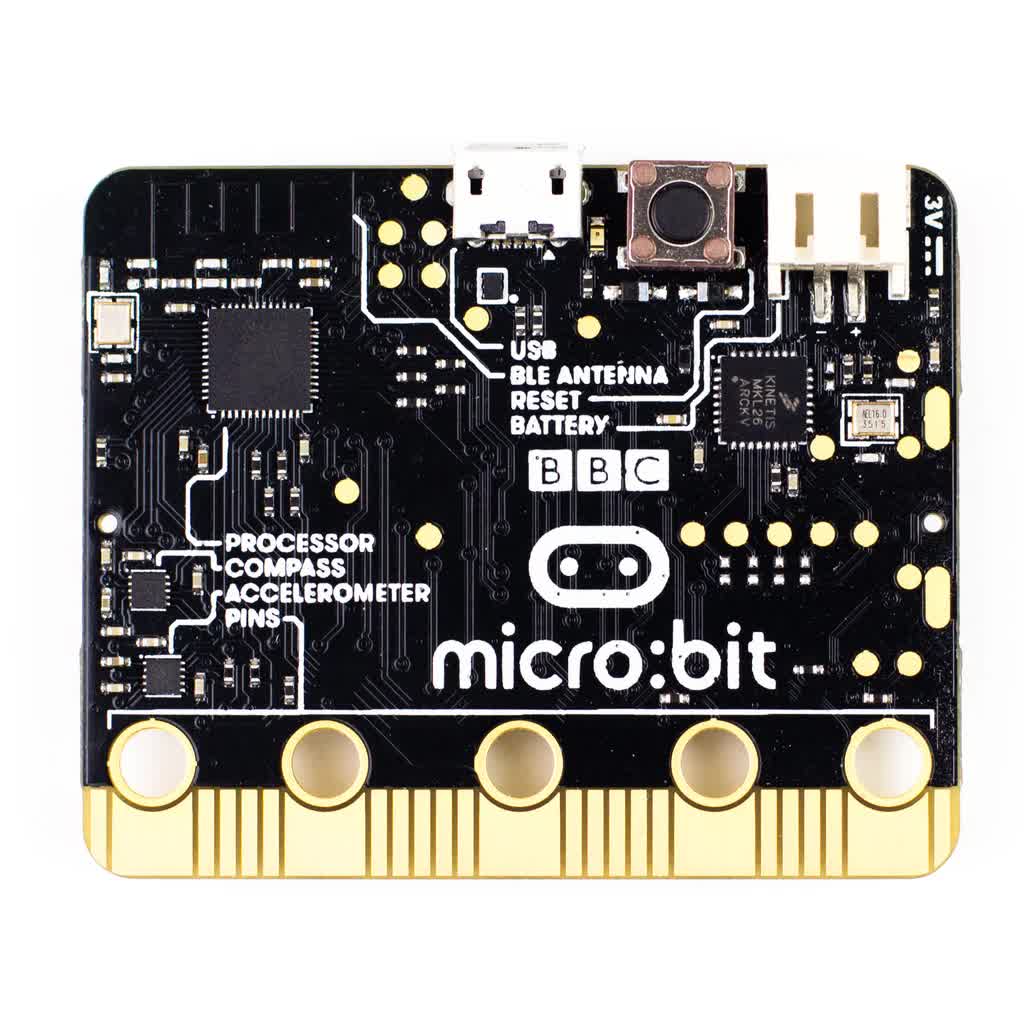 |
From the micro:bit page on Wikipedia:
page on Wikipedia:
 for use in computer education in the UK.
for use in computer education in the UK.
The device is described as half the size of a credit card and has an ARM Cortex-M0 processor, accelerometer and magnetometer sensors, Bluetooth and USB connectivity, a display consisting of 25 LEDs, two programmable buttons, and can be powered by either USB or an external battery pack. The device inputs and outputs are through five ring connectors that form part of a larger 25-pin edge connector.
processor, accelerometer and magnetometer sensors, Bluetooth and USB connectivity, a display consisting of 25 LEDs, two programmable buttons, and can be powered by either USB or an external battery pack. The device inputs and outputs are through five ring connectors that form part of a larger 25-pin edge connector.
The micro:bit can be programmed in Microsoft MakeCode (a graphical language), Python, and Scratch
(a graphical language), Python, and Scratch .
.
The micro:bit is available from many vendors, and it clearly makes sense to shop for the best value (and the best value based on currency). Some options:
- micro:bit
 £13.50 from Pimoroni
£13.50 from Pimoroni
- BBC micro:bit
 US$14.95 from Adafruit
US$14.95 from Adafruit
- BBC micro:bit Go Bundle
 US$17.50 (with USB cable, battery pack and 2x batteries) also from Adafruit
US$17.50 (with USB cable, battery pack and 2x batteries) also from Adafruit
- BBC Micro:Bit in Gift Box (Microbit)
 £11.75 from 4Tronix
£11.75 from 4Tronix
Contents
- BBC micro:bit board
- Recommendation
- Available micro:bit Robots
- M.A.R.S. Rover Robot for Microbit or Pi Zero
- Waveshare Alphabot
- micro:Maqueen Plus
- micro:Maqueen Lite
- Bit:Bot
- Bit:Bot XL
- MiniBit
- :MOVE Mini
- Robot:bit MK3
- Adafruit CRICKET for micro:bit
- Related Products
- Kitronik ZIP Halo HD for micro:bit
- Ultrasonic Sensor Module
- BitFace Robot Face Breakout
- References
Recommendation#
Which of the many robotic microcomputer/microcontroller platforms (Raspberry Pi, Arduino, micro:bit, etc.), which of the various programming environments (graphical, Python, MicroPython, C++, assembly language), and then which specific robot to choose has as much to do with one's requirements as which robot is most appealing to the eye. There's also the question as to whether to purchase a ready-made robot, a kit, or design-your-own from either an existing system or a bespoke robot from available parts (truly "on your own"). And also whether to purchase something that grows with one's experience or is limited to the specifics of the chosen robot. I don't consider "age level" really much of a factor since it's pretty clear that a 10 year old and a 70 year old may share the same level of previous experience, interest, and ingenuity. But having the flexibility of multiple programming environments is a factor in any robot's favour.
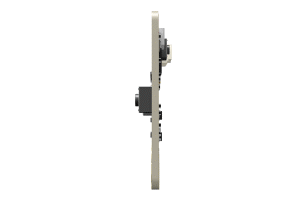 |
The mini-Zumo robots are appealing if competition within a group is a requirement. These are generally Arduino-based, so they'd be programmed in C++. But they're pretty limited beyond line following and knocking each other out of the ring.
For a "club robot", i.e., something that a group of people can cooperatively work on together, sharing ideas and designs, something that has a wide range of programming opportunities, and something that is very well-documented and used by a huge number of people, well, the BBC micro:bit platform is hard to beat. The micro:bit can be used as a learning tool outside of robotic applications, and because of its edge connector needn't be soldered or permanently connected to a robot.
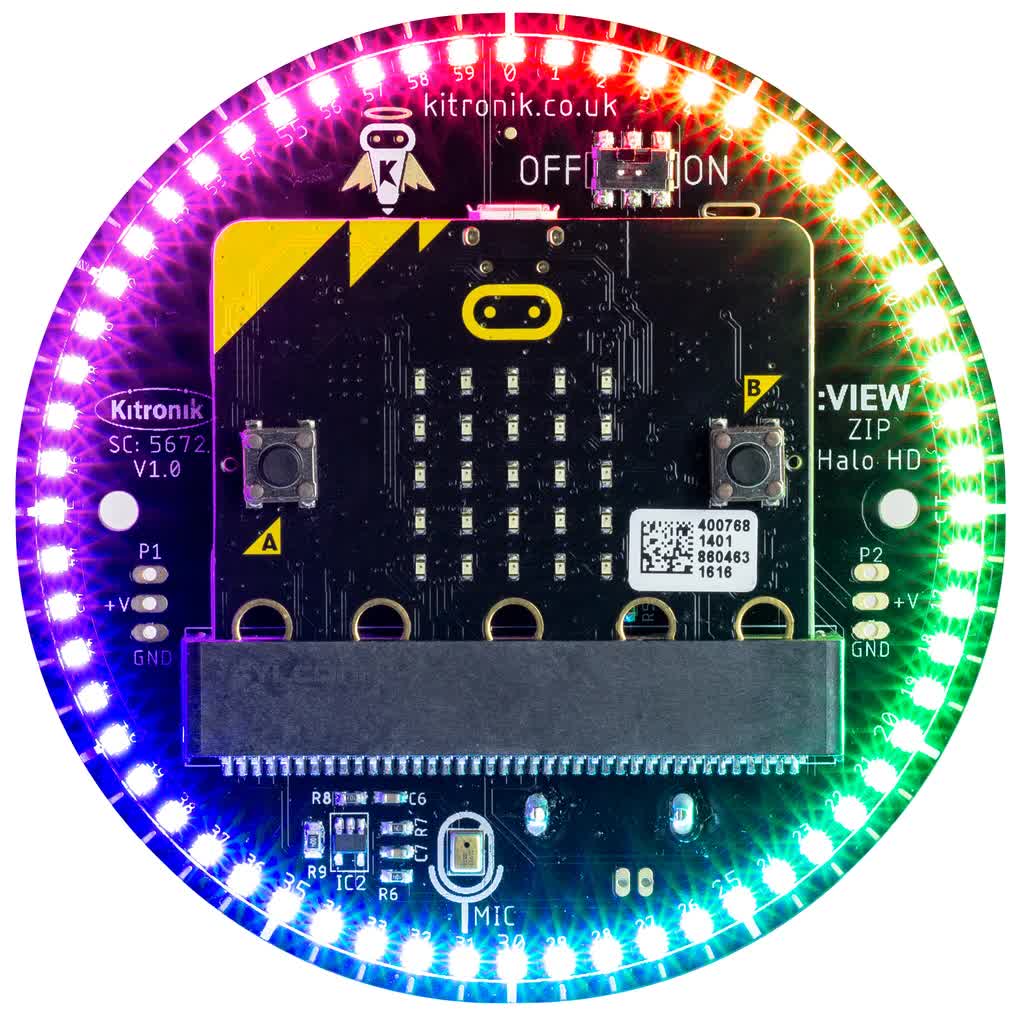 |
Among the many micro:bit based robots the major factors were: durability, expandability, features-vs-cost, and lastly, aesthetics. While appearance may be considered important to children, my guess is that it's the parents who believe that cuteness counts. It probably does for the first ten minutes. After the cuteness wears off a child probably wants a robot that is something they can learn with and be intrigued by, one with a bit of depth. A Lego kit that can only be built one way is less interesting over the long haul than a set of Lego blocks that can continue to spur the imagination over many years.
With that said, our first choice for a micro:bit robot is the Waveshare Alphabot, as it has a lot of features for the money, and is probably the most durable of the micro:bit robots listed below. The DFRobot micro:Maqueen Plus or micro:Maqueen Lite are likewise great choices. The Plus has a lot of expansion capabilities, even an AI "smart" camera that can be trained to recognise objects and colours.
I'm a bit of a fan of the 4Tronics products, having used their PiconZero Raspberry Pi controller. Their robots are visually appealing but less expandable and likely a bit more fragile than the aforementioned choices. They typically have a marker holder to let the robot draw on a piece of paper, but frankly I'd be concerned with having a marker-laden robot running over my wood floors. Line following and exploration are probably more interesting and educational endeavours.
While this may seem a bit advanced for beginners, the availability of motor encoders and a PID controller (in order to perform odometry) has been strongly recommended by members of the DPRG as a very valuable learning opportunity. The only robot that provides this functionality is the micro:Maqueen Plus, so if you're interested in learning the basics of odometry that'd be the first choice.
as a very valuable learning opportunity. The only robot that provides this functionality is the micro:Maqueen Plus, so if you're interested in learning the basics of odometry that'd be the first choice.
It'd be possible to add motor encoders to the Waveshare Alphabot, but that would entail swapping out the existing micro metal gear motors for ones with an extended motor shaft and one of the three motor encoder options (all available from Pololu ). Not trivial, but certainly doable.
). Not trivial, but certainly doable.
Available micro:bit Robots#
Generally, unless stated otherwise the micro:bit board is not included with the robot kits.
M.A.R.S. Rover Robot for Microbit or Pi Zero#
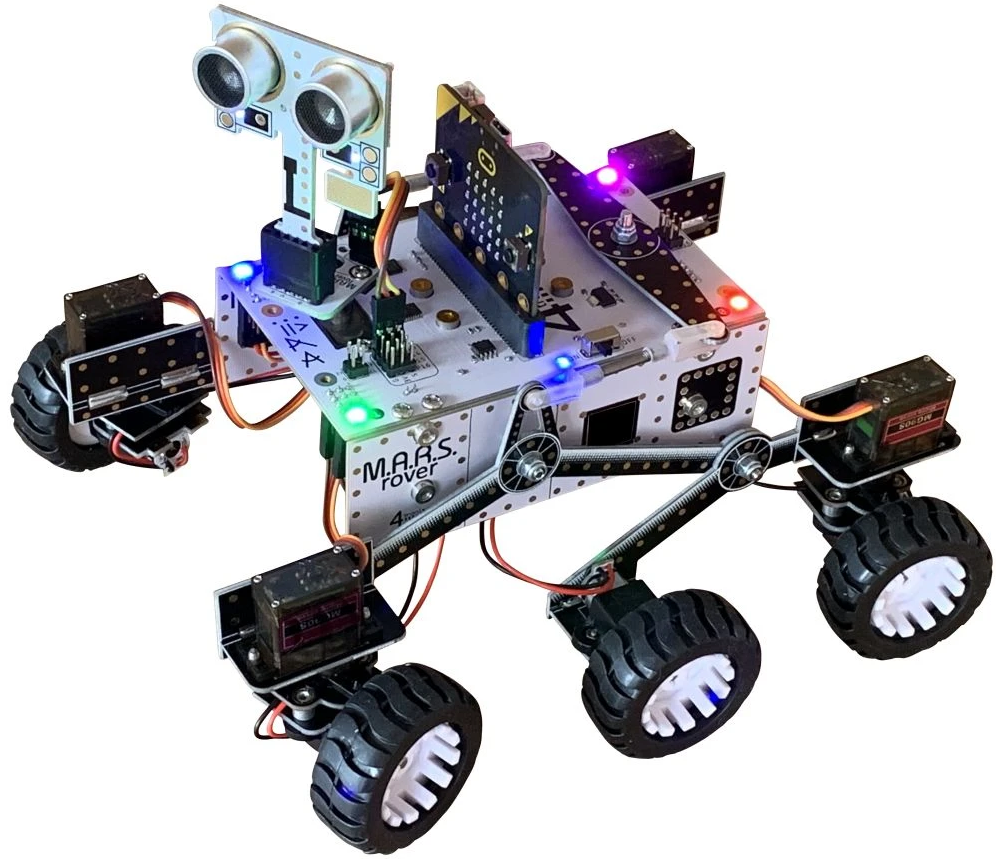 |
This is by far the most complicated micro:bit based robot available, and is certainly not an entry-level robot. This uses six micro metal gear motors and four servos.
It's included in the list here so you can see that a micro:bit robot need not be limited by any notion of the simplicity of its controller. You can also purchase a version of the Rover that uses a Raspberry Pi Zero W.
Waveshare Alphabot#
 |
- Waveshare AlphaBot2 2WD Platform Kit for BBC micro:bit. US$63.99 without micro:bit
 from RobotShop, or US$81.99 including micro:bit
from RobotShop, or US$81.99 including micro:bit directly from Waveshare
directly from Waveshare
The Waveshare AlphaBot2 2WD Platform Kit for BBC micro:bit is designed to use with the BBC micro:bit (there are also versions of the Alphabot2 for Raspberry Pi and Arduino). It features rich common robot functions including line tracking, infrared obstacle avoiding, ultrasonic ranging, Bluetooth/2.4G remote control, etc.
This robot is not as pretty as some of the others (no rainbow flashing LEDs) but is probably one of the more advanced, durable and better-designed of the micro:bit robots. It is also available for Arduino and Raspberry Pi.
See also:
micro:Maqueen Plus#
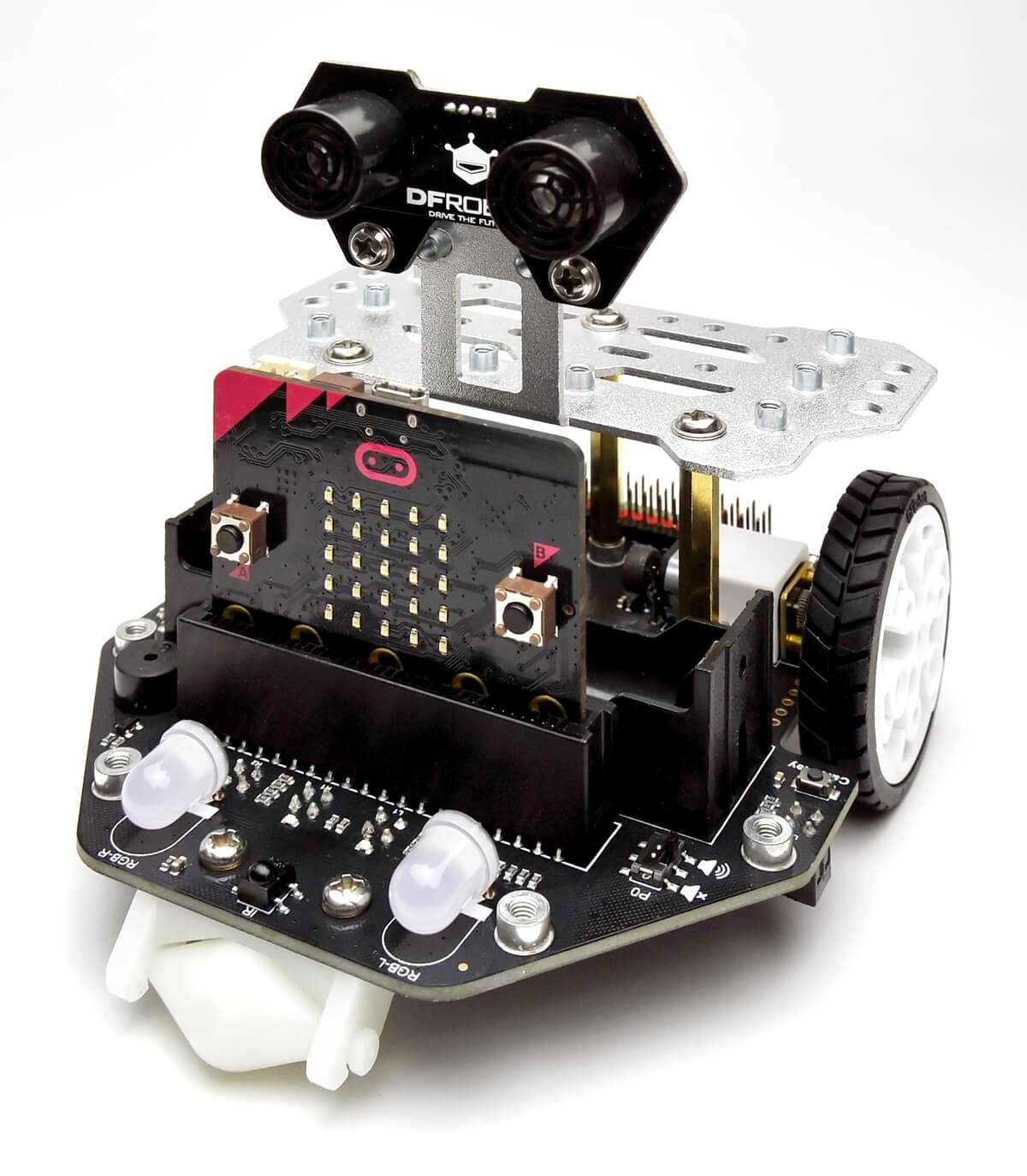 |
- micro: Maqueen Plus
 US$49.90, US$78.90 with "Mechanic" option
US$49.90, US$78.90 with "Mechanic" option
 which makes it an accessible AI robot teaching tool.
which makes it an accessible AI robot teaching tool.
In addition, micro:Maqueen Plus comes with a larger and more stable chassis, more built-in functions and more expansion ports, it is not only suitable for classroom teaching, but also can be suitable for after-school extended exercises and robot competitions.
There are also expansion kits available which add mechanical actuators (e.g., gripper, loader), a gamepad controller, and a HuskyLens (AI camera). As compared with the Lite version it also has a battery charging circuit (for a 2500mAh LiPo battery), motor encoders with a PID controller, large RGB LEDs up front, a lot more IO ports and even a line tracking map.
micro:Maqueen Lite#
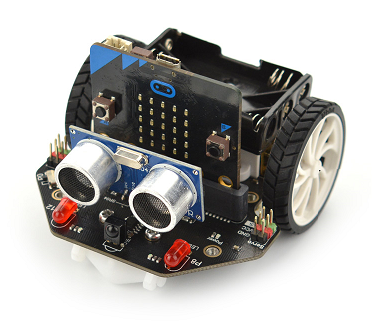 |
- micro: Maqueen Lite-micro:bit Educational Programming Robot Platform
 US$24.90, with micro:bit based Gamepad (and 2x micro:bit): US$82.50
US$24.90, with micro:bit based Gamepad (and 2x micro:bit): US$82.50
- Introducing Micro:Maqueen micro:bit Robot Platform
 (YouTube) promotional video from DFRobot
(YouTube) promotional video from DFRobot
- Smartphone controlled Robot Micro:bit
 - (Youtube) promotional video showing robot programmed via iPhone application
- (Youtube) promotional video showing robot programmed via iPhone application
- Best DIY Robot kit for beginners - Micro:Bit
 (YouTube) amateur video demonstrating this robot
(YouTube) amateur video demonstrating this robot
Maqueen is a graphical programming robot for STEM education, which inherits playability and simple operation of micro:bit. The Maqueen Lite is the smaller sibling to the Maqueen Plus.
Maqueen is accessible to the Mind+ Programming platform now. Mind+ is a Scratch3.0-based graphical programming platform from DFRobot, supporting python, Arduino and other programming platforms. At present, Mind+ has been applied to all kinds of sensors, modules and related educational products.
Bit:Bot#
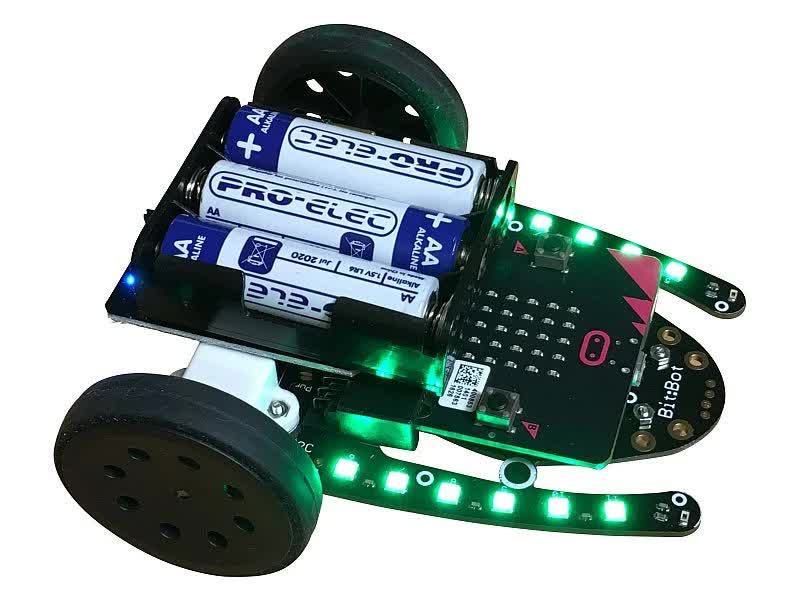 |
- 4Tronix Bit:Bot
 £39.90
£39.90
It appears the Bit:Bot may be replaced by the Bit:Bot XL, as the former no longer appears on the 4Tronix website (though it is still available from some vendors).
Bit:Bot XL#
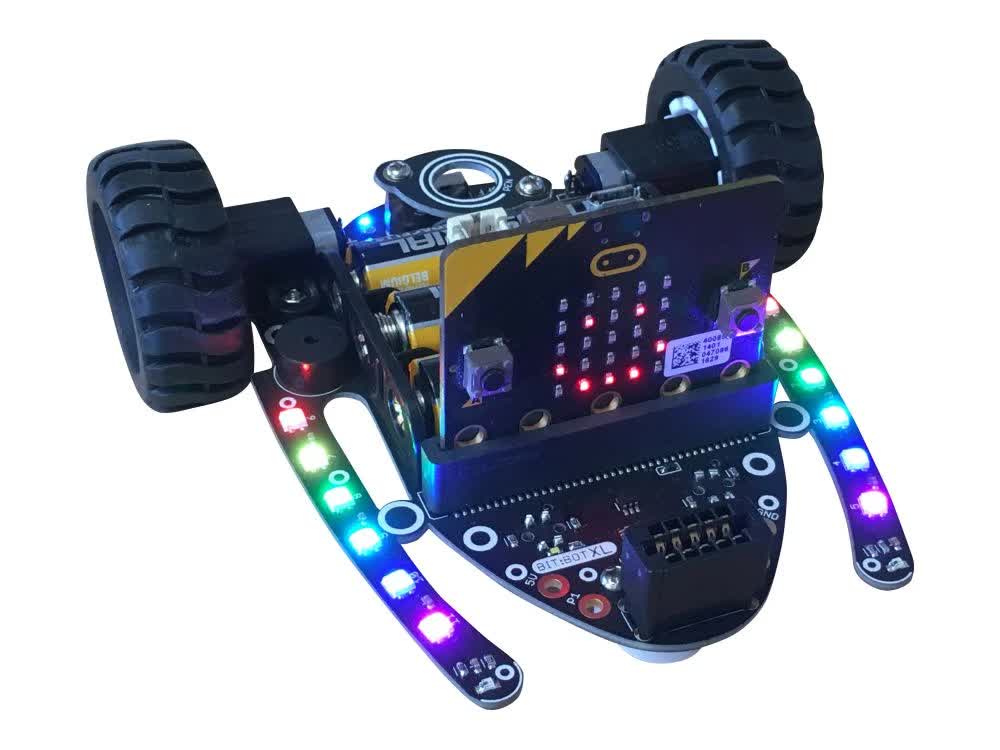 |
MiniBit#
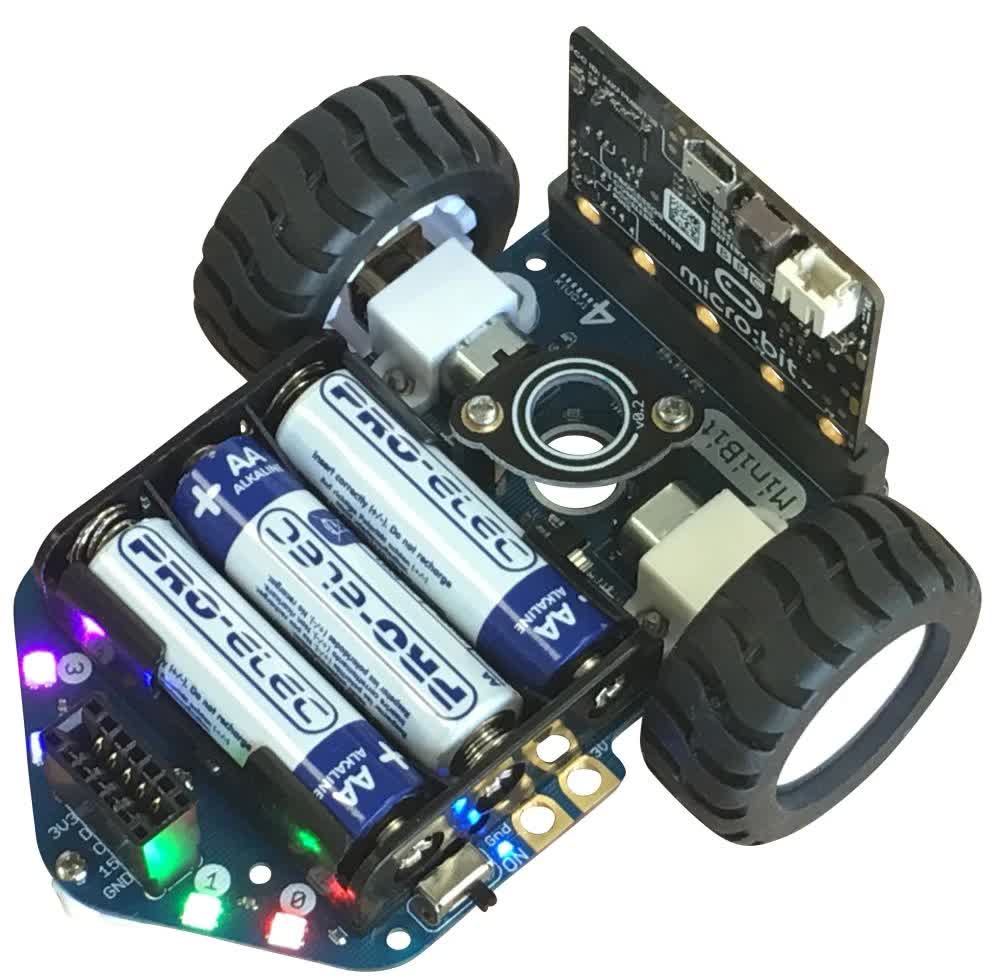 |
The Minibit is the younger sibling of the popular and well-loved Bit:Bot. It comes ready-built (wheels need pushing on).
A Makecode extension is available. Blocks available for driving the motors, LEDs and optional ultrasonic sensor and line follower module as well as the other plugin breakouts.
:MOVE Mini#
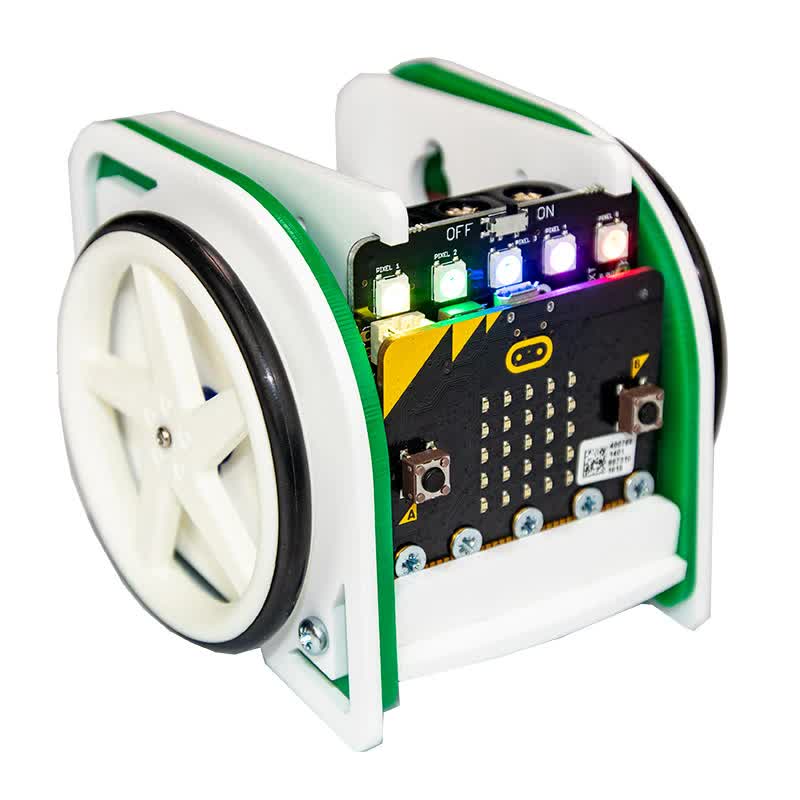 |
- :MOVE mini MK2 buggy kit
 £27.60
£27.60
Robot:bit MK3#
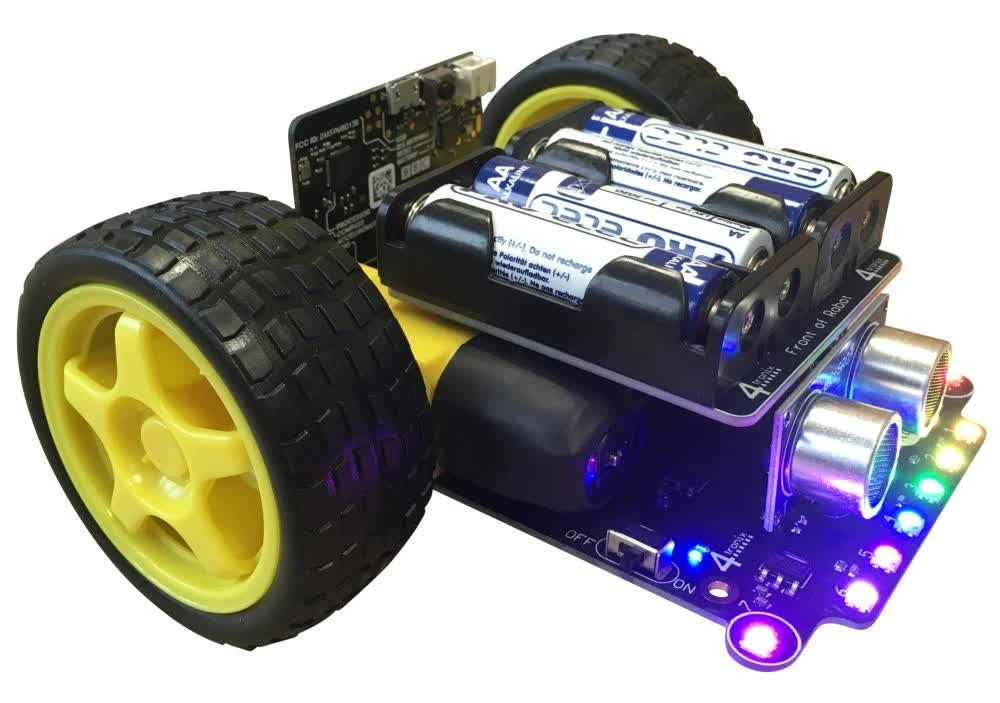 |
Version 1.3 of this popular kit now uses a removable ultrasonic sensor, that uses the same connector as used on the Minibit and BitBot XL. This allows the use of alternative addons, such as the new BitFace, 5x5 FireLed Matrix and OLED.
Adafruit CRICKET for micro:bit#
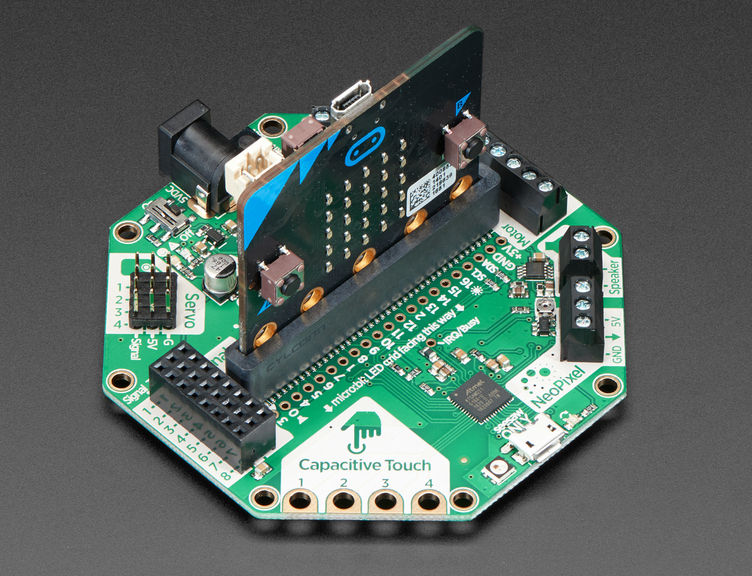 |
- Adafruit CRICKIT for micro:bit
 US$29.95
US$29.95
Plug your micro:bit into the 40 pin edge connector and start controlling motors, servos, solenoids. You also get signal pins, capacitive touch sensors, a NeoPixel driver and amplified speaker output. It complements & extends micro:bit so you can still use all the goodies on the micro:bit, but now you have a robotics playground as well.
This is similar to the Adafruit Crickit used on the KC01 robot (which uses a Raspberry Pi rather than a micro:bit).
Related Products#
Kitronik ZIP Halo HD for micro:bit#
 |
Ultrasonic Sensor Module#
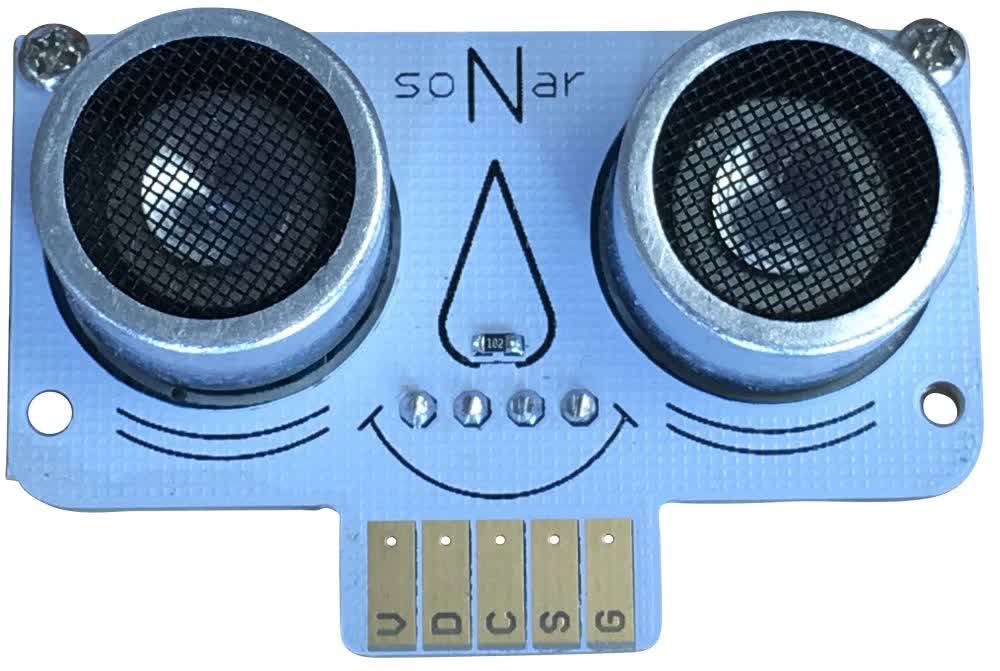 |
This breakout is a simple and robust way to add ultrasonic distance sensing to your robot. Supported on BitBot XL, Pi2Go Mk2, Pi-Bug (v1.1 and later), Minibit and other 4tronix robots released from July 2019 onwards (including the Robobit Mk3, v1.3 onwards).
Available in standard and tall versions. The Tall version is intended for the BitBot XL with a Talon attachment. We recommend using the standard version for all other use cases.
BitFace Robot Face Breakout#
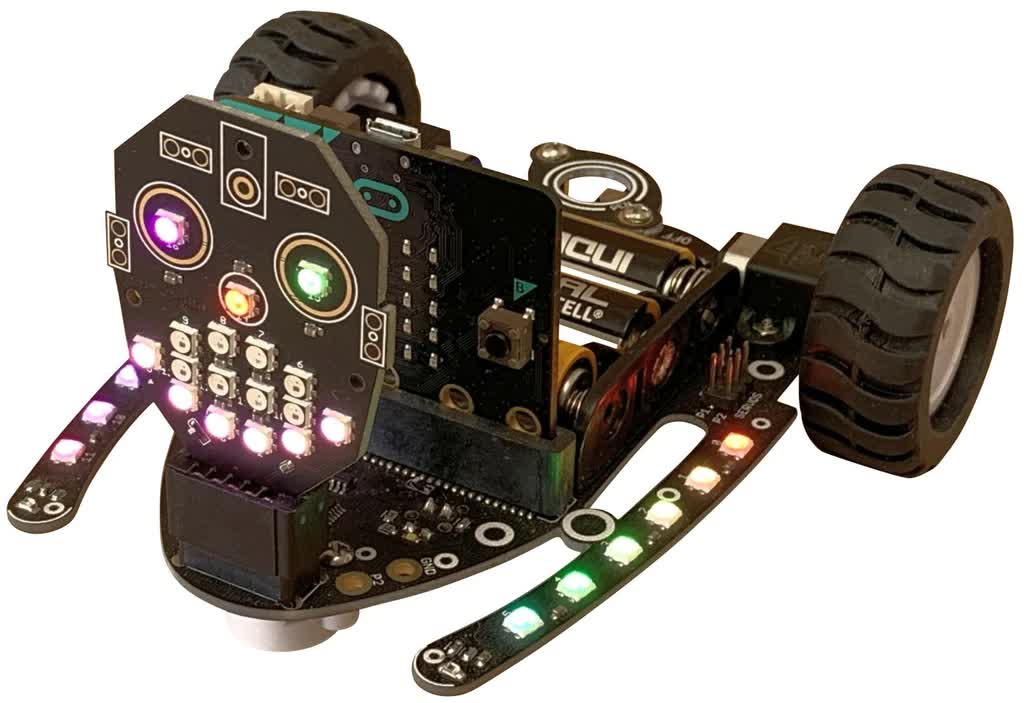 |
(Note that you can't use a BitFace and an Ultrasonic sensor at the same time, as they both plugin into the same socket.)